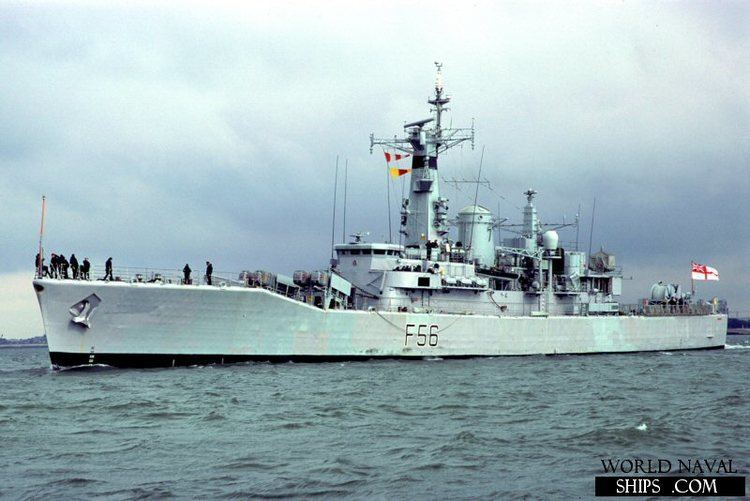Name HMS Argonaut (F56) Laid down 27 November 1964 Decommissioned 31 March 1993 Construction started 27 November 1964 Length 113 m | Commissioned 17 August 1967 Launched 8 February 1966 Draft 5.8 m | |
 | ||
Builder Hawthorn Leslie and Company | ||
HMS Argonaut (F56) was a Leander-class frigate of the Royal Navy. She was built by Hawthorn Leslie and Company of Hebburn. She was launched on 8 February 1966 and commissioned on 17 August 1967. On 31 March 1993, Argonaut was decommissioned. She was broken up a few years later.
Contents
1967–1982
In her first year, Argonaut escorted the liner Queen Mary on her final voyage to the United States where Queen Mary would then become a hotel and museum-ship.
In 1971, Argonaut, like many other Royal Navy vessels, took part in the long-running Beira Patrol, a United Nations operation that was designed to prevent oil reaching Rhodesia via the Portuguese colony of Mozambique, due to Rhodesia having declared unilateral independence under the rule of Prime Minister Ian Smith in 1965, a move that was widely condemned across the world.
In 1973, Argonaut recommissioned, completed a six-week 'work up' at Portland, visited Brest in France and completed a stint as Gibraltar guard ship. Also, following Iceland's declaration of a 200-mile fishing limit, Argonaut carried out fishery protection duties for British trawlers inside that area, in what became known as the Second Cod War.
In 1974, from mid January, Argonaut spent nine months as part of the group deployment, Task Group 317.1, led by Flag Officer Second Flotilla (Commander Task Group 317.1). The other ships in the task group were the County Class destroyer HMS Fife, the frigates of the 7th Frigate Squadron (of which Argonaut was one): HMS Ariadne, HMS Danae, HMS Londonderry, and HMS Scylla (Captain 7th Frigate Squadron), and two Royal Fleet Auxiliaries (one tanker and one solid stores).
In November 1974 "Argonaut" carried out fishery protection duties in the Barents Sea. During this period she visited Hammerfest and Honningsvag in Norway to take on fuel. Before returning to Devonport she visited Newcastle, Tyne and Wear.
In early 1975 "Argonaut" took part in the annual NATO 'Gate' exercise (called 'Locked Gate' or 'Open Gate' in alternating years), and visited Lisbon before returning to Devonport.
Argonaut joined the Standing Naval Force Atlantic (Stanavforlant) by late 1975.
Argonaut underwent Exocet modernisation between 1976–80, giving her a potent anti-ship capability.
In 1981, Argonaut deployed as the Armilla Patrol ship in the Persian Gulf.
Falklands War, 1982
In 1982 the Falkland Islands were invaded by Argentina. An advanced group of British vessels began to steam towards Ascension Island on 2 April, a territory that would play a strategic part during Operation Corporate. On 19 April, Argonaut, along with Ardent and two Royal Fleet Auxiliary ships Regent and Plumleaf finally headed for Ascension Island. On the 29th, the group finally arrived at Ascension, and on 6 May the Argonaut Group departed the island for the Falklands. On the 16th, the Group joined the large Amphibious Group centred on Fearless and Intrepid, and on the 18th the Group met up with the Carrier Battle Group.
On 21 May Argonaut, along with other destroyers and frigates, provided close escort for the amphibious vessels during the successful landing at San Carlos Water. On that day, Argonaut was attacked twice by Argentine aircraft. The first attack, carried out with cannon fire and rockets by an Argentine Navy Aermacchi MB-339, flown by Lieutenant Crippa, caused some damage, including to her Type 965 radar. The second attack was launched by five A-4 Skyhawks call sign Leo, which hit Argonaut with two bombs. Neither exploded, although one killed two sailors, Able Seaman Iain M. Boldy and Able Seaman Matthew J. Stuart, when it entered the ship's Sea Cat missile magazine, detonating two missiles. Plymouth came to the assistance of Argonaut and towed her away from immediate danger. Both bombs were still active, and it took some days to deactivate them. This was very risky work, as demonstrated on 24 May when Antelope sank after an unexploded bomb detonated while British Army experts were attempting to deactivate it.
On 14 June Argentine forces in the Falklands surrendered, ending the 74 days war. On 26 June Argonaut arrived home to Devonport Dockyard, where she underwent repairs for her battle damage. During the repairs, new sonar equipment was fitted.
1982–1993
Argonaut came into the spotlight in 1987, when Richard Branson, attempting to cross the Atlantic in a hot-air balloon had to ditch. Argonaut rescued Branson, retrieved his balloon and transported it back to safety.
In 1990, Argonaut was present at the 75th Anniversary of the Gallipoli landings, where many Government officials from a number of countries, as well as Gallipoli veterans, were present to mark the event. On 31 March 1993, Argonaut was decommissioned and broken up two years later.
